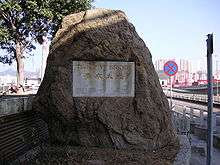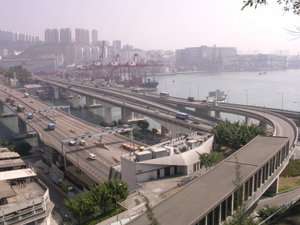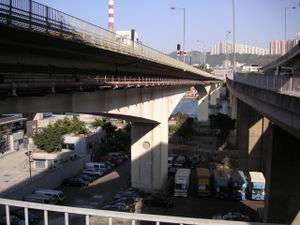Tsing Yi Bridge
| Tsing Yi Bridge | |||||||||||
 | |||||||||||
| Traditional Chinese | 青衣大橋 | ||||||||||
|---|---|---|---|---|---|---|---|---|---|---|---|
| Simplified Chinese | 青衣大桥 | ||||||||||
| |||||||||||
Tsing Yi Bridge is the first bridge to the Tsing Yi Island of Hong Kong. It crosses Rambler Channel, connecting Tsing Yi Island and Pillar Island of Kwai Chung. The bridge spans 610 metres (about 2,000 feet) and is 26 metres (85 feet) high. It contributed significantly to the development of Tsing Yi Island, particularly in the 1970s and 1980s.
History
The bridge was built by Tsing Yi Bridge Company Limited (青衣大橋有限公司), a joint venture of six Hong Kong companies on the island, namely, China Light and Power, Hong Kong Cement (香港水泥), International Containers (國際標準貨箱), Mobil Oil (美孚石油), Gulf Oil (高富石油) and Standard Oil (標準石油). In 1970, they budgeted 18 million Hong Kong dollars to build the bridge, and Hong Kong Government contributed 7.5 million to the road connection. The construction was by Gammon (Hong Kong).
Its final cost was 17 million Hong Kong dollars and was completed in February 1974. On 28 February 1974, Sir Murray MacLehose, the Governor of Hong Kong, opened the bridge. Upon completion, the bridge was given to Hong Kong Government and the Government built roads to link up various areas on the island.
There are two lanes on the bridge. Before the rebuilding, the bridge was two-way; afterwards, two lanes are outward bound, and the Tsing Yi Doubling Bridge serves inward traffic.
It is also known as Tsing Yi South Bridge (青衣南橋), or simply South Bridge (南橋), upon the completion of Tsing Yi North Bridge in 1987.
A stone was erected on the Pillar Island end of the bridge in memory of the completion. The stone was moved to the Tsing Yi end to spare space for building the Tsing Yi Doubling Bridge.
Connection
Tsing Yi Bridge is connected to Tsing Yi Road and Tsing Yi Heung Sze Wui Road on Tsing Yi Island, and Kwai Tsing Road and Tsing Kwai Highway in Kwai Chung.
Structure

Tsing Yi Bridge is formed by 5 levers, identical pairs of arms supported by stands, 18 metres (60 feet) above the water, in the middle, with round-shaped caissons on the seabed.
The arms are made of pre-tensioned concrete. Their cross section is of hollow boxes. There are some power cables and two oil pipes inside the boxes. Both sides of hollow boxes have water pipes for the Tsing Yi Island.
On the bridge, 7 metres (24 feet) width is provided for vehicles with a 1.5 metre (5 foot) wide pedestrian walkway on each side.
The bridge is designed to withstand typhoons, strong waves and accidental collisions by ships.
Collision
Ships operating in nearby water and passing through have collided with the bridge several times, and caused minor damage to the bridge. Protection islands are built on the channel to avoid further accidents. Warning signs have been erected reminding that only ships under 17 metres are allowed to sail through the channel. Ships are prohibited from staying or operating near the bridge.
Aging and Renovation

Tsing Yi Bridge once was the sole connection of the Tsing Yi island to the rest of Hong Kong. As residential population grew, the bridge loading was exceeded. The two lanes become a traffic bottleneck and serious traffic congestion ensued. Heavy overloading, with dramatic increases in heavy vehicle traffic, made the bridge age quickly and the gap edge bent downward. Though later Tsing Yi North Bridge was built thus alleviating the congestion a bit, and the bridge was closed once in 1989 (after the opening of the North bridge) for renovation, the safety of the bridge was still a major concern. Finally, a rescue plan was implemented. A new bridge, Duplicate Tsing Yi Bridge, was built alongside to at first to replace Tsing Yi Bridge temporarily while Tsing Yi Bridge was closed for fixing in 2000.[1] Some tensioned steel cables replaced the aging cables inside the bridge to straighten out the bent parts. After the project completed, the Tsing Yi Bridge, together with its 'new' brother, served the island again.
Celebration
On the 10th birthday of the bridge, a carnival was held on the football field, near Chan Lai So Chun Memorial School, of Cheung Ching Estate on the Tsing Yi Island.
Footnotes
References
- "Tsing Yi North/South Bridges". The Film Services Office. Retrieved 2007-02-24.
See also
| Wikimedia Commons has media related to Tsing Yi Bridge. |
Other cross-channel bridges:
- across Rambler Channel:
- across Ma Wan Channel
Coordinates: 22°20′55.3″N 114°6′48.9″E / 22.348694°N 114.113583°E